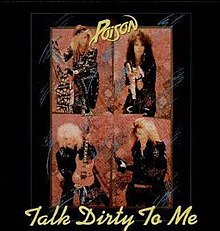Talk Dirty to Me
| "Talk Dirty to Me" | ||||
|---|---|---|---|---|
 | ||||
| Single by Poison | ||||
| from the album Look What the Cat Dragged In | ||||
| B-side | "Want Some, Need Some" | |||
| Released | February 18, 1987 | |||
| Recorded | 1986 | |||
| Genre | Glam metal[1][2][3] | |||
| Length | 3:44 | |||
| Label | Enigma/Capitol | |||
| Songwriter(s) | ||||
| Producer(s) | Ric Browde | |||
| Poison singles chronology | ||||
| ||||
"Talk Dirty to Me" is the second single from American glam metal band Poison, originally from the album Look What the Cat Dragged In. The song peaked at #9 on the Billboard Hot 100, becoming the band's first top 40 hit in the United States.
Reception[]
In 2017, Billboard magazine placed the song at No. 1 on their list of "The 10 Best Poison Songs".[4]
Music video[]
Classic Rock ranked the song's video at No. 7 on their list of The Top 10 Best Hair Metal Videos.[2]
Lawsuit[]
The song, along with "I Won't Forget You", "Fallen Angel", and "Ride the Wind", was the subject of a lawsuit in 2011 by members of the defunct band Kid Rocker, who claimed that the songs were based on Kid Rocker songs played to Poison guitarist C.C. DeVille before he was a member of Poison.[5]
Charts[]
Weekly charts[]
| Chart (1987) | Peak position |
|---|---|
| Australia (Kent Music Report)[6] | 55 |
| Canada Top Singles (RPM)[7] | 9 |
| UK Singles (OCC)[8] | 67 |
| US Billboard Hot 100[9] | 9 |
Year-end charts[]
| Chart (1987) | Position |
|---|---|
| Canada Top Singles (RPM)[10] | 74 |
References[]
- ^ Christopher, Michael (May 25, 2017). "Rock Music Menu: Chris Cornell: The last great rock star". Delaware County Daily Times. Retrieved March 2, 2019.
- ^ Jump up to: a b Johnson, Howard (July 21, 2016). "The Top 10 Best Hair Metal Videos". Classic Rock Magazine. Retrieved March 15, 2021.
- ^ Talk Dirty to Me - Poison | Song Info | AllMusic, retrieved 2021-04-06
- ^ "Poison's 10 Best Songs: Critic's Picks". Billboard. Retrieved 2021-05-30.
- ^ "POISON Responds To Song Theft Allegations". Blabbermouth.net. 27 October 2011. Archived from the original on 27 October 2011. Retrieved 28 October 2011.
- ^ Kent, David (1993). Australian Chart Book 1970–1992 (Illustrated ed.). St. Ives, N.S.W.: Australian Chart Book. p. 36. ISBN 0-646-11917-6. N.B. The Kent Report chart was authorized by ARIA from 1970 to 1988.
- ^ "RPM - Library and Archives Canada - RPM - Bibliothèque et Archives Canada". collectionscanada.gc.ca. 17 July 2013. Retrieved August 21, 2020.
- ^ "Official Singles Chart Top 100". Official Charts Company. Retrieved August 21, 2020.
- ^ "Poison Chart History (Hot 100)". Billboard. Retrieved August 21, 2020.
- ^ "Top 100 Singles of '87". RPM. Archived from the original on July 13, 2015. Retrieved August 21, 2020.
External links[]
Categories:
- 1986 songs
- 1987 singles
- Songs written by Bobby Dall
- Songs written by Bret Michaels
- Songs written by Rikki Rockett
- Songs written by C.C. DeVille
- Poison (American band) songs
- Enigma Records singles
- Capitol Records singles
- Songs about sexuality